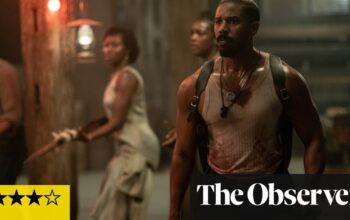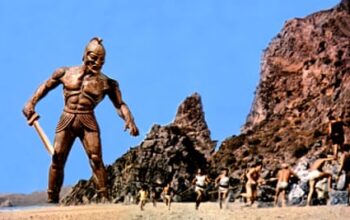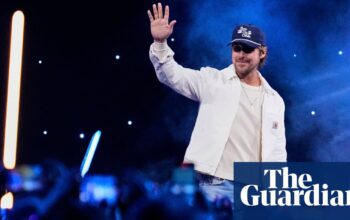A
As we approach the 2024 Academy Awards, Martin Scorsese’s film Killers of the Flower Moon, based on David Grann’s nonfiction book of the same name, is being heavily predicted as a top contender for major awards. Last month, this drama about the true story of the Osage murders, orchestrated by white men in an attempt to take control of the oil-rich land from Indigenous people in Oklahoma during the early 20th century, was named the best film of 2023 by Sight and Sound. During the holiday season, Awards Daily listed Killers of the Flower Moon as the front runner for Best Picture, while Variety predicted that Scorsese and actress Lily Gladstone would receive Oscar nominations and that Leonardo DiCaprio, who has been nominated eight times and won for The Revenant in 2016, would earn his eighth nomination for his role as both lead actor and executive producer.
Due to the recent attention around their accolades, it’s not surprising that DiCaprio and Gladstone are now actively promoting their film after the resolution of the actors’ strike. DiCaprio is known for not being a big fan of press interviews, but he seems enthusiastic about supporting his co-star Gladstone, who has a lot to say about the film. When I asked for a place to put my recording device, DiCaprio performed a humorous skit of rearranging furniture before settling back on the sofa with Gladstone, allowing her to take the spotlight.
“This story has been long awaited,” Gladstone comments on the tale of love, death, and betrayal. The narrative follows the marriage of Ernest Burkhart, a white man portrayed by DiCaprio, to Osage woman Mollie Kyle, played by Gladstone. This union was motivated by Ernest’s desire to inherit Mollie’s family’s oil rights, all set against a backdrop of murder and exploitation. “The Osage community avoided discussing it for many years, as it was a recent and painful wound. When David Grann’s book was published, it brought up old wounds. However, sometimes reopening wounds is necessary for the healing process to begin. Unfortunately, the book is not included in the curriculum of public schools in Oklahoma due to teachers’ fear of teaching it. Therefore, it is crucial to have a film that brings this history to light and allows people to connect with it. This representation has been long overdue.”
For Gladstone, who grew up on the Blackfeet Nation reservation, and whose previous acting credits include Kelly Reichardt’s Certain Women and First Cow, the key to that “moment of representation” is the degree to which members of the Osage Nation were involved in the film’s development, and the number of Indigenous actors on screen. Indeed, she argues that the casting and production of Killers of the Flower Moon marks a watershed moment in Hollywood, with potential to change the industry.
The speaker expresses excitement about the future prospects for TV shows and movies created by Native individuals. She highlights the stark contrast between these upcoming projects and the past portrayal of Indigenous people as violent savages in traditional westerns. These depictions lacked representation of Indigenous women in leading roles, unlike classic Hollywood productions. The speaker finds it empowering to finally have an exceptional Indigenous cast in such roles that have been historically inaccessible. The influence and involvement of Osage individuals in the making of Killers of the Flower Moon has greatly impacted the final product. The speaker hopes that this will set a new standard for Hollywood to collaborate with and accurately represent communities.
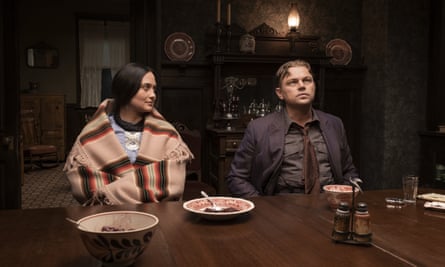
I inquire DiCaprio about his involvement in revising the script for the film, which was crucial in incorporating the Osage community in Killers of the Flower Moon. He had been attentively listening to Gladstone and made sure not to interrupt. “The process took a long time,” he explains with a sigh. “We acquired the rights to the book, and that was particularly thrilling for me because it shed light on a forgotten part of American history. Through my environmental activism, I have seen many Indigenous communities across the globe facing similar situations. These environmental advocates are at risk due to the actions of major oil, drilling, and mining companies. Therefore, we cannot view this story as something that happened 100 years ago. This was a region abundant in oil and resources, but also plagued with conflict, and unfortunately, this is still happening everywhere.”
Director Scorsese, who shared a strong interest in the captivating narrative, began working on a screenplay based on Grann’s book. The focus of the book was mainly on the origins of the FBI and the pivotal role played by law officer Thomas Bruce White Sr in the investigation of the Osage murders. Initially, this role was intended for DiCaprio but after a year or two of development, the team found that they were not emotionally connected to the story during read-throughs. It wasn’t until Lily became involved that they realized the potential of the story as a compelling whodunnit, reminiscent of Hitchcock’s style. However, the director expressed that he was not interested solely in the plot and structure, but rather in the emotional depth of the story.
“We began examining the scenes between Mollie and Ernest and realized that they were the core of the story. This also allowed us to delve deeper into the Osage community, leading us to completely revamp the script. Our new draft was heavily influenced by films such as A Place in the Sun and The Heiress, resulting in a twisted and unconventional love story. Marty was then invited by the Osage to gain a deeper understanding of their perspective on the events. With Lily’s involvement, the story took on a completely new structure.”
How did Scorsese make an effort to truly understand the Osage people?
Gladstone states that Osage was the one who offered the invitation. He explains that the community of Gray Horse has been interested in the film since the book was published. As the project progressed with Leonardo DiCaprio and Martin Scorsese, Gray Horse collectively wrote a letter inviting them to come to their community, have dinner, and discuss any thoughts or concerns about the adaptation. Scorsese accepted the invitation.
Despite including Osage input, Killers of the Flower Moon still received many negative reactions. Devery Jacobs, a Native Canadian actor who portrays Elora in the TV show Reservation Dogs, expressed her disappointment with the film on social media. She called it “painful, grueling, and unnecessarily graphic” and stated that the Indigenous actors were the only redeeming aspect of the film. She also questioned whether this type of representation was truly necessary after a century of harmful portrayals of Indigenous communities in cinema.
Despite their utmost endeavors, it appears that the filmmakers were unable to satisfy everyone.
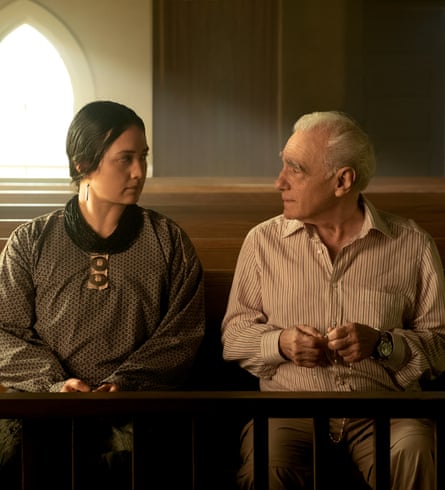
Display the image in full screen mode.
Gladstone states that art does not have to please everyone, but rather, the most important thing is that the Osage community approves of it. He has received positive feedback from most of the community, including those who were not involved in the film. Former chief Jim Gray, who was originally opposed to the film, had a change of heart after watching it and even posted a lengthy and glowing review on Twitter. This was significant to Gladstone as he valued Jim’s opinion. Despite some of his closest friends initially avoiding him due to skepticism about the film’s portrayal of a dark part of the tribe’s history, they have since become fans of it. While there may be differing opinions within the Osage Nation, there seems to be overall support and a sense of protectiveness towards the film.
In its finished form, Killers of the Flower Moon centres on a relationship that is clearly abusive – a white incomer marrying into an Indigenous community in order to inherit and steal the oil money that has made their land wealthy. Yet on screen, DiCaprio and Gladstone conjure a sense of intimacy between Ernest and Mollie that is at odds with that entirely exploitative narrative, hinting at something more tender beneath the surface. How would the actors characterise Ernest and Mollie’s relationship?
DiCaprio reflects, as his character is the compliant nephew of Robert De Niro’s oily mastermind William King Hale, one of the main instigators of the atrocities committed against the Osage people. “It’s an intriguing concept,” he ponders. “This Mollie-Ernest dynamic is almost unfathomable to a writer. Obviously, their relationship was incredibly abusive. But was there a genuine connection? In Oklahoma, you have a situation where a predominantly white population has overtaken Indigenous land. However, after speaking with members of the community, we learned that while Hale has been erased from memory and history books due to his evil deeds, Ernest was different. He was under Hale’s manipulation as his nephew. He bears great responsibility for his actions. But we consistently heard that there was a true bond and bond between Ernest and Mollie – something tangible.”
I propose that feeling connected is essential to fully engaging with Scorsese’s film. Without this connection, viewers may have felt detached from the deceitful and convoluted events. If everything is simply a plot to kill, it becomes difficult to emotionally invest in the story.
“Exactly!” exclaims DiCaprio. “It was evident. In fact, even after the trial, Mollie and Ernest were frequently spotted driving around Fairfax as a couple. In essence, I find it hard to believe that their relationship lasted for as long as it did without there being genuine feelings involved.”
Gladstone shares that many Caucasian men married Osage women, and vice versa. Despite this, they did not attempt to learn each other’s language. Ernest, who was not well-educated, managed to pick up the language and communicate with his family and children. DiCaprio interjects with a laugh, clarifying that Ernest was not highly intellectual. As is common when marrying into Native American communities, Ernest found an accepting and communal family that he belonged to. He also had his own cultural background and the oppressive patriarchal influence that came with it.
O
As they converse, the topic shifts to activism and protecting the environment – a topic that is important to both of them. While Gladstone has stated that “acting is my activism”, DiCaprio has gained recognition as an eco-friendly celebrity. In a survey conducted by the Hollywood research group, the majority of 1,500 individuals aged 18 to 64 named DiCaprio as the most trusted public figure or celebrity when it comes to sustainability, surpassing Greta Thunberg, Al Gore, Dwayne “The Rock” Johnson, and President Joe Biden.
Leonardo DiCaprio explains that he has been involved in addressing climate change for a significant amount of time. He has noticed a common belief that it is solely the responsibility of individuals, perpetuated by governments and the private sector. While individuals do have a role to play, governments must also take action by changing policies and holding nations and the private sector accountable for their global emissions. DiCaprio mentions the importance of technologies like carbon sequestration and AI supercomputers in finding solutions. He emphasizes that this is a crucial undertaking for civilization and humanity, as it affects future generations and all life on Earth. While some may believe that the Earth will still exist, the quality of life for its inhabitants must also be considered.
My current focus is on the question of how we can preserve the natural world. This involves protecting the caretakers of the land, such as local communities and Indigenous peoples who have been doing so for centuries. My foundation’s main focus is now centered around the concept of saving nature by providing 100% of our funds to these Indigenous groups on the ground. We aim to empower and support local communities in their efforts to protect these areas rather than exploit them for resources, and to shield them from large corporations that seek to clear land for cattle farming, soy or palm oil production. This approach ultimately safeguards the diverse array of species that coexist within these environments.
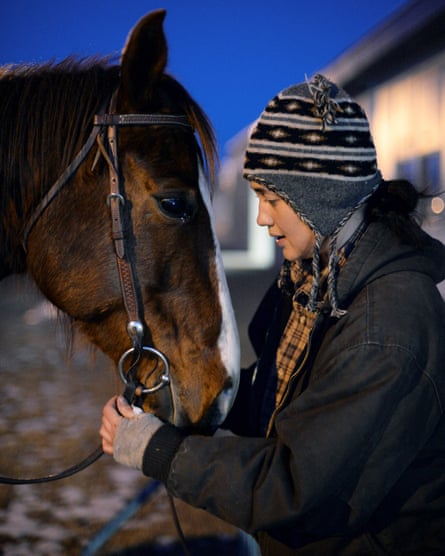
According to Gladstone, one aspect of Leo’s activism that he greatly admires is its recognition of individuals and grassroots efforts, regardless of political affiliations. Throughout history, people have always been influenced by the decisions of those in power. However, no matter how the political landscape changes, there will always be a grassroots resistance at the human level. This movement will always have a strong Indigenous presence and will be joined by allies who prioritize caring for the Earth and their community, regardless of political beliefs. It focuses on directly addressing the needs of people on this planet, bypassing government actions.
Taking into consideration De Niro’s outspokenness regarding the danger that Donald Trump poses to the United States and the rest of the world, what is their level of concern or hopefulness regarding the upcoming American election?
Leonardo DiCaprio, who consciously steers clear of making provocative anti-Trump statements like his co-star Gladstone, admits that his response is lengthy. He expresses uncertainty about the future direction of our country and observes a growing division on various matters. In terms of environmental concerns, he has typically aligned with a certain political party – the one that aligns with the vast majority of scientific research, which he supports. He firmly believes in the importance of science.
I have a vivid memory of working on a film called “Before the Flood” where I had the opportunity to speak with a NASA scientist. It was the first time I was given a map of Earth and the scientist pointed out the equatorial line and explained that as the Earth warms, we can expect to see an increase in fires, drought, and loss of trees. At the time, I lived in Los Angeles, which is close to the equator. It’s been seven years since then and we are now witnessing these events happening exactly as predicted. Unfortunately, one political party has continuously denied the warnings from the scientific community and has not prioritized protecting our climate.
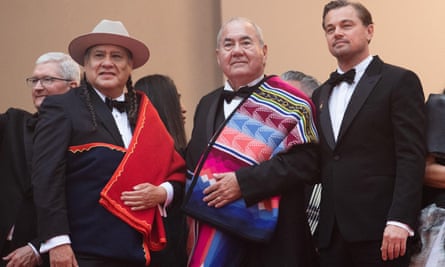
Display the image in full screen mode.
Instead of focusing on the urgent climate crisis, I wonder if we could talk about something less important. DiCaprio chuckles and suggests discussing things like our favorite colors. However, I am more interested in how the actors’ strike was handled by each individual.
After a prolonged period of quiet, Gladstone finally speaks up.
“I found it frustrating not being able to speak about the film,” she expresses with exhaustion. “I wanted to truly represent it, but there was a silver lining in that it set a new precedent for films like this. Since the actors couldn’t speak, it was wonderful to see the Osage people take the lead and share their thoughts on the film. I always try to find the positive in every situation, even if it may be a strength or flaw of mine. It was truly inspiring. As actors, we put our all into our characters and the story, and once filming is over, there is often a discussion about who the film belongs to – the creators or the audience. In this case, it was only fitting that we handed over the art to the Osage people first and allowed their voices to be heard.”
Is DiCaprio experiencing the same emotions?
“Look, Marty’s been out on the campaign trail because we haven’t been able to speak about it,” he replies. “But if I’m being quite honest, I really wanted to have Lily be able to have a pulpit to talk about this movie. And it’s been interesting to hear her perspective and what it means. So what can I say about the actors’ strike? Nobody worked! You know. And now, we’re gonna get back to work! And I’m glad it’s all over.”
Is DiCaprio ever annoyed by the media’s fascination with his personal life?
Regarding my personal life, my answer is straightforward. I started working in this industry at a young age because I felt a strong desire to do so. Interestingly, I grew up in Hollywood, so people assume it was easy for me to get into the industry. However, I faced multiple rejections when trying to become an actor until one agent finally gave me a chance at 12 or 13 years old. Since then, it has felt like winning the lottery. Honestly, I would have been content with any type of acting job, whether it be commercials or television.
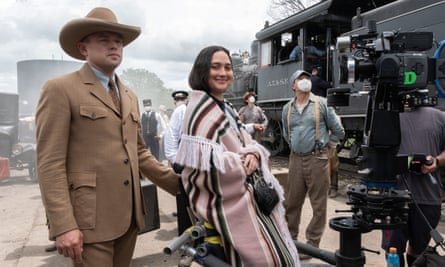
I had the chance to work on This Boy’s Life with Robert De Niro. Watching his performance made me realize what a great actor he is, and I promised myself I would not waste this opportunity. Along with this experience, came the loss of privacy. However, I know there are people who face much tougher challenges than having their personal life exposed. It’s just one of the consequences that come with my profession, and I am grateful for the chance to do what I love. I have learned to accept it and adjust accordingly.
Our allotted time is coming to an end and I have one final inquiry for both individuals: what do you admire most about each other? DiCaprio directs his attention to Gladstone, showing clear determination for her to respond first.
“I have mentioned it multiple times,” she states. “And it truly is the highest compliment I can give someone. He is a true nerd! He becomes fully engrossed in everything he is passionate about. His level of dedication and enthusiasm is admirable. He may be modest about it, but it’s fascinating and inspiring to witness his passion and investment in things.”
What is the most positive aspect of Lily, according to Leonardo?
“I have many thoughts, but I believe she is a kind-hearted individual,” he grins. “I tend to observe small details in people, and she is involved in some incredible activism. She’s wonderful – I don’t want to delve too deeply into it – to her loved ones and her community. She is a knowledgeable scholar of her own past in many respects. I always take note of the little things, and she consistently displays incredible grace and kindness towards everyone.”
Gladstone appears sincerely touched. “Thank you,” she murmurs.
Since you mentioned it, what is the color you prefer the most?
Gladstone laughs as he switches between green and blue.
And you, Leonardo?
“Blue.”
Lily asks him if his preferred color is blue due to his fondness for Captain Planet.
Leo DiCaprio grins, “It’s always been my favorite color, maybe because I’m just a guy.”
They both burst into laughter.
-
The film “Killers of the Flower Moon” can be viewed on Apple TV+ starting January 12th.
Source: theguardian.com
